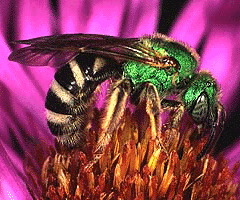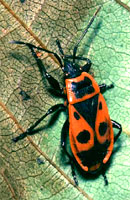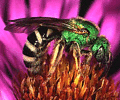Neoptera



This tree diagram shows the relationships between several groups of organisms.
The root of the current tree connects the organisms featured in this tree to their containing group and the rest of the Tree of Life. The basal branching point in the tree represents the ancestor of the other groups in the tree. This ancestor diversified over time into several descendent subgroups, which are represented as internal nodes and terminal taxa to the right.

You can click on the root to travel down the Tree of Life all the way to the root of all Life, and you can click on the names of descendent subgroups to travel up the Tree of Life all the way to individual species.
For more information on ToL tree formatting, please see Interpreting the Tree or Classification. To learn more about phylogenetic trees, please visit our Phylogenetic Biology pages.
close boxIntroduction
The neopterous insects include the Hemipteroid Assemblage, Endopterygota, as well as the "lower Neoptera". The "lower Neoptera" include the Plecoptera, Embidiina, Zoraptera, and the "orthopteroid" orders (all the remaining living orders shown in the tree above).
Characteristics
Neopterous insects primitively have the ability to fold the wings back over their abdomen, using special structures at the base of their wings. Key to the folding mechanism is the third axillary sclerite and pleural wing-folding muscle.
This ability to fold the wings back over the abdomen has been lost in some small groups within Neoptera, including various butterflies and moths.
Discussion of Phylogenetic Relationships
The relationships of the orthopteroid orders to one another, and their relationship to plecopterans (stoneflies), embiids (web-spinners), and zorapterans, are unsettled. The placement of the plecopterans, embiids, and zorapterans are perhaps the most enigmatic.
Hennig (1969, 1981) considered the zorapterans to be sister to the hemipteroid complex, the stoneflies to be relatively basal, and the web-spinners to be the sister group to the orthopteroid orders:
========= Hemipteroid Assemblage
===|
======| ========= Zoraptera
| |
| ============ Endopterygota
|
|================= Plecoptera
|
| ============ Embiidina
=====| |
| | ====== Orthoptera
| | ===|
| | | ====== Phasmida
======| |
===| ====== Grylloblattodea
| |
===| === Dermaptera
===|
=== Dictyoptera
Boudreaux (1979) considered the web-spinners to be the sister to stoneflies with zorapterans nested within the orthopteroids:
============ Hemipteroid Assemblage
======|
| ============ Endopterygota
|
| ============ Plecoptera
|=====|
| ============ Embiidina
|
| ========= Orthoptera
=====| ===|
| | ========= Phasmida
| |
| | ========= Dermaptera
======| |
| | ====== Grylloblattodea
===| |
===| === Zoraptera
===|
=== Dictyoptera
More recent analyses using molecular data have still not been able to establish a well supported hypothesis of neopteran relationships; e.g., Flook and Rowell (1998) suggested the following topology based on their analysis of SSU rRNA sequences (Endopterygota and Zoraptera not included in analysis):
=============== Hemipteroid Assemblage
|
| ============ Dictyoptera
=====| |
| | ====== Grylloblattodea
| | |
| |=====|===== Plecoptera
===| |
| ====== Dermaptera
|
| === Phasmida
| ===|
======| === Embiidina
|
====== Orthoptera
Wheeler et al. (2001) favor the following relationships based on a combined analysis of morphological and molecular data:
========= Hemipteroid Assemblage
===|
| ========= Endopterygota
|
| ====== Zoraptera
| |
=====| |===== Dictyoptera
| ===|
| | |===== Dermaptera
| | |
| | ====== Grylloblattodea
===|
| === Phasmida
| ===|
| | === Orthoptera
===|
| === Embiidina
===|
=== Plecoptera
The tree shown at the top of this page reflects the cautious views of Kristensen (1991), and is perhaps a clearer indication of our current knowledge about relationships of these orders.
References
Ali, D. W. and D. C. Darling. 1998. Neuroanatomy and neurochemistry: implications for the phylogeny of the lower Neoptera. Canadian Journal of Zoology 76(9):1628-1633.
Beutel, R. G. and S. N. Gorb. 2001. Ultrastructure of attachment specializations of hexapods, (Arthropoda): evolutionary patterns inferred from a revised ordinal phylogeny. Journal of Zoological Systematics and Evolutionary Research 39:177-207.
Carpenter, F. M. 1992. Superclass Hexapoda. Volume 3 Part R, Arthropoda 4 of Treatise on Invertebrate Paleontology. Boulder, Colorado, Geological Society of America.
Flook, P. K. and C. H. F. Rowell. 1998. Inferences about orthopteroid phylogeny and molecular evolution from small subunit nuclear ribosomal DNA sequences. Insect Molecular Biology 7(2):163-178.
Gaunt, M. W. and M. A. Miles. 2002. An insect molecular clock dates the origin of the insects and accords with palaeontological and biogeographic landmarks. Molecular Biology and Evolution 19(5):748-761.
Haas, F. and J. Kukalová-Peck. 2001. Dermaptera hindwing structure and folding: New evidence for familial, ordinal and superordinal relationships within Neoptera (Insecta). European Journal of Entomology 98(4):445-509.
Kevan, D. K. M. 1977. The higher classification of the orthopteroid insects. Mem. Lyman Entomol. Mus. Res. Lab. 4 (Spec. Publ. No. 12):1-79.
Kjer, K. M. 2004. Aligned 18S and insect phylogeny. Systematic Biology 53(3):506-514.
Klass, K. D. 1999. The pregenital abdomen of a mantid and a cockroach: Musculature and nerve topography, with comparative remarks on other Neoptera (Insecta: Dictyoptera). Deutsche Entomologische Zeitschrift 46(1):3-42.
Klass, K. D., O. Zompro, N. P. Kristensen, et al. 2002. Mantophasmatodea: A new insect order with extant members in the afrotropics. Science 296(5572):1456-1459.
Kukalová-Peck, J. and C. Brauckmann. 1992. Most Paleozoic Protorthoptera are ancestral hemipteroids: major wing braces as clues to a new phylogeny of Neoptera (Insecta). Canadian Journal of Zoology 70:2452-2473.
Maekawa, K., O. Kitade, and T. Matsumoto. 1999. Molecular phylogeny of orthopteroid insects based on the mitochondrial cytochrome oxidase II gene. Zoological Science 16(1):175-184.
Rentz, D. C. F. 1996. Grasshopper Country: The Abundant Orthopteroid Insects of Australia. New South Wales University Press Ltd, Sydney. 356 pp.
Storozhenko, S. Y. 1997. Fossil history and phylogeny of orthopteroid insects. Pages 59-82 in The Bionomics of Grasshoppers, Katydids and Their Kin. S. K. Gangwere, M. C. Muralirangan, and M. Muralirangan, eds. CAB International, Oxon, UK & New York.
Terry, M. D. and M. F. Whiting. 2005. Mantophasmatodea and phylogeny of the lower neopterous insects. Cladistics 21(3): 240-257.
Vickery, V. R. and D. K. M. Kevan. 1983. A monograph of the orthopteroid insects of Canada and adjacent regions. Lyman Entomological Museum and Research Laboratory Memoir 13:216-237.
Wheeler, W. C., M. Whiting, Q. D. Wheeler, and J. M. Carpenter. 2001. The phylogeny of the extant hexapod orders. Cladistics 17:113-169.
Title Illustrations

| Scientific Name | Dactylotum variegatum |
|---|---|
| Comments | A grasshopper (Orthoptera) |
| Specimen Condition | Live Specimen |
| Copyright |
© 1995 Joseph L. Spencer

|
| Scientific Name | Halictidae |
|---|---|
| Comments | A halictid bee (Endopterygota: Hymenoptera) |
| Specimen Condition | Live Specimen |
| Copyright |
© 1995 Joseph L. Spencer

|
| Scientific Name | Pyrrhocoris apterus |
|---|---|
| Comments | A bug (Hemipteroid Assemblage) |
| Creator | Photograph by Jean-François Cornuet |
| Specimen Condition | Live Specimen |
| Copyright |
© BIODIDAC

|
About This Page
Page copyright © 2003
All Rights Reserved.
Citing this page:
Tree of Life Web Project. 2003. Neoptera. Version 01 January 2003 (under construction). http://tolweb.org/Neoptera/8267/2003.01.01 in The Tree of Life Web Project, http://tolweb.org/











 Go to quick links
Go to quick search
Go to navigation for this section of the ToL site
Go to detailed links for the ToL site
Go to quick links
Go to quick search
Go to navigation for this section of the ToL site
Go to detailed links for the ToL site